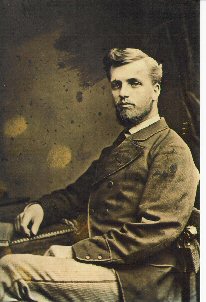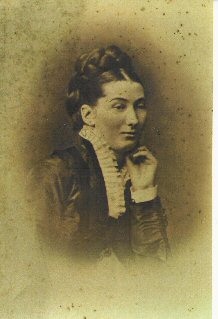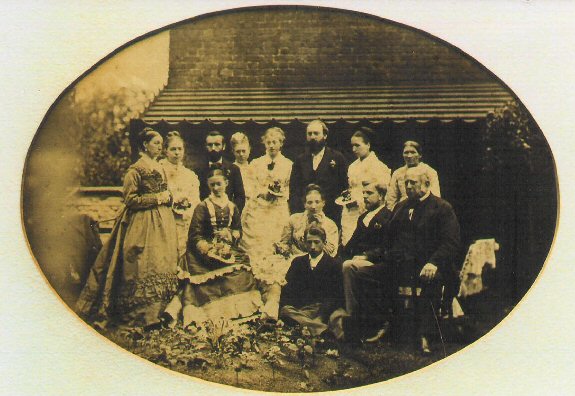

My Saul Ancestors
By Jack Earl
This article was originally published in the December 2004 edition of Soul Search, the journal of The Sole Society
JAMES SAUL (1806 - 1895)
James was born in Mundesley in 1806, was trained as a tailor and at the time of the 1841census was living at Row 32, Great Yarmouth. This fits in very well with the fact that I have inherited a handsome copy of Vol III of Goldsmith's "History of the Earth and Animated Nature" (with coloured illustrations), inscribed "James Saul, King's Head Row, Yarmouth, 1842." Row 32 was commonly known as King's Head Row after the pub which stood at its Market Place end.
Yarmouth was built on a long narrow sandbank and to make the best use of the available space the old town within the walls consisted basically of three long parallel streets and a waterfront, running north to south, with 145 narrow Rows running east to west between them. Charles Dickens stayed in the town in about 1848 while writing "David Copperfield" and a few years later wrote about the Rows in the magazine Household Words:
"A Yarmouth Row is long narrow lane or alley, quite straight, or as nearly so as may be, with houses on each side, both of which you can sometimes touch at once with the finger tips of each hand, by stretching out your arms to their full extent... A few rows are well paved throughout with flag-stones... Hence they are the chosen locality of numerous little shopkeepers. If you want a stout pair of hob-nailed shoes, or a scientifically oiled dreadnought, or a dozen bloaters, or a quadrant or compass, or a bunch of turnips the best in the world, or a woollen comforter and nightcap for one end of your person, and worsted overall stockings for the other, or a plate of cold boiled leg of pork stuffed with parsley, or a ready made waist-coat with blazing pattern and bright glass buttons - with any of these you may be accommodated in one or other of the paved rows."
Is it unreasonable to suggest that Dickens may have been looking into Great-Grandfather's shop-window? Perhaps he bought the waist-coat!
James must have moved to Yarmouth because it was developing as a fashionable resort. The first Sea Baths were opened in 1760 and a Hot Bath was opened two years later "for the convenience of such as may be advised to use one," and soon advertisements are addressed to "the nobility and gentry" visiting the town "for the Bathing Season". Certainly James seems to have flourished as the 1851 reports that he was living in East Nettle Hill, which is one of the new residential areas outside the old walls. I suspect that he would have kept his old shop in the business centre. (The street is still there but I haven't yet had time to go and check whether No.6 is still standing.)
JOSEPH HOLLAND GOTT SAUL (1849 - 83)
 My
Grandfather was a Victorian schoolmaster and one of the earliest trainers of
teachers. He presumably began teaching in Norfolk but by 1870, when he was only
21, he was on the staff of St. Mark's College, London, almost certainly as Head
of the Practice School. I have a number of volumes of Dickens and Scott all
inscribed "Joseph H.G. Saul, Saint Mark's College, from the First Year Students
as a token of respect." I also have a copy of Herschel's "Physical Geography"
inscribed "Queen's Prize obtained by Joseph H.G. Saul, 1870."
My
Grandfather was a Victorian schoolmaster and one of the earliest trainers of
teachers. He presumably began teaching in Norfolk but by 1870, when he was only
21, he was on the staff of St. Mark's College, London, almost certainly as Head
of the Practice School. I have a number of volumes of Dickens and Scott all
inscribed "Joseph H.G. Saul, Saint Mark's College, from the First Year Students
as a token of respect." I also have a copy of Herschel's "Physical Geography"
inscribed "Queen's Prize obtained by Joseph H.G. Saul, 1870."
At some unknown date he moved to Holbeck, Leeds, to start a teacher-training establishment. He was apparently Head of St. Luke's School and in charge of a group of student-teachers who lived in the large, purpose-built Bath House, where my mother and her brother and sister were born. Some years ago, when I was working in the West Riding, I managed to find both the house and the school building - the latter was then occupied by the Gas Board. Sadly, Joseph died of T.B. when only 34. Even now Holbeck seems to be surrounded by factories and railway tracks and it must have been a dreadfully unhealthy place in the 19th century. I like to think that he would have been pleased to know that his grandson was working in those parts as one of H.M.lnspectors of Schools - and that one of his great-granddaughters is now training teachers at Cambridge. He certainly started a family tradition - I was a teacher, I married a teacher and all our children are teaching in either school or university.
I feel that there is some mystery about his moves from Yarmouth to London, and then from London to Leeds - and about two of his baptismal names, which have no family connection. My own theory is that he had a patron, possibly a local vicar, and I hope to be able to find out something about this.
SOPHIA SAUL (Nee ANDREWS) (c1851 - 1935)
 Joseph
married Sophia Andrews in 1875 and, according to my Aunt Beatrice (always known
as Aunt Cissie), when he died the family was rescued by one of her brothers, who
took them to live with him in his big house beside the river Waveney at
St.Olaves, where he had an artificial fertiliser factory. Until I received the
Society's papers, I had no idea that James Saul was living with them at Holbeck
and that he outlived his son by 12 years. Nobody ever mentioned him to me and I
can only conclude that the Andrews family took complete control.
Joseph
married Sophia Andrews in 1875 and, according to my Aunt Beatrice (always known
as Aunt Cissie), when he died the family was rescued by one of her brothers, who
took them to live with him in his big house beside the river Waveney at
St.Olaves, where he had an artificial fertiliser factory. Until I received the
Society's papers, I had no idea that James Saul was living with them at Holbeck
and that he outlived his son by 12 years. Nobody ever mentioned him to me and I
can only conclude that the Andrews family took complete control.
Again, according to my aunt, the children went for some time to the primary school at Haddiscoe, across the river. She used to say that there was a boy in her class who was good at drawing and was always passing his pictures round the class; she wished she'd kept some of them because his name was Munnings and he later became President of the R.A.
Sophia (who was also often known as
Beatrice) was an enterprising young woman and before long she moved into Norwich
and opened a Stationery and Fancy Goods shop in White Lion Street near the
Market Place, presumably living above the shop. The children went to good
schools - I have a "Complete Works of Shakespeare" which my mother, Constance
Saul, won as a prize at the Diocesan Model School for Girls in 1894, when she
was 14. It must have been at about this time that her mother attracted the
attention of John Rout, who owned a large ironmongery shop in the same street -
and a good many other things beside. He was a widower with seven children (plus
three who had died in infancy) and he obviously felt that Sophia was just the
right woman to cope with a big family.
 They
were married in 1895 at St.Peter Mancroft, the huge church which overshadows the
Market Place. Sophia's financial worries were over, for John was the sort of
businessman for whom everything always turns to gold - but I sometimes think
that her children must have found the sudden arrival of three new brothers and
four sisters something of a shock.
They
were married in 1895 at St.Peter Mancroft, the huge church which overshadows the
Market Place. Sophia's financial worries were over, for John was the sort of
businessman for whom everything always turns to gold - but I sometimes think
that her children must have found the sudden arrival of three new brothers and
four sisters something of a shock.
By the time I arrived on the scene they were living in a grand house, Marlborough House, which John had built almost opposite the Hospital. It was rather like the "Cluedo" house; it had both a large conservatory and a full-size billiard room - all great fun for a small boy to explore. And my abiding memory of my grandmother is of a kind and dignified old lady always dressed like Queen Victoria, usually sitting by the fireside, quietly and efficiently directing the work of the household as one daughter, several step-daughters and two servants obediently carried out her instructions. It was all a long way from Bath House in the slums of Holbeck, but perhaps the experience the young Sophia must have had in coping with student-teachers may have proved good training for her later life.
I have many vivid memories of Marlborough House, especially memories of the wonderful two-day Christmas parties which John and Sophia organised every year throughout my childhood. Now even the house has gone, destroyed by incendiary bombs during the "Baedeker raids", fortunately when no-one was living there.
HENRY JAMES B. SAUL (1877 - 1954) and BEATRICE MARY SAUL (1879 - 1962)
Neither Henry ("Uncle Harry") nor Beatrice (Aunt Cis) ever married. They joined the Rout household in 1895 but in due course Harry left to work in a bank (his Uncle Dick Andrews was a manager). When I first knew him he was working at Halesworth in Suffolk. During the 1914 -8 War he served as a member of a howitzer crew in the Royal Garrison Artillery. When he retired from the bank he and Aunt Cis set up house together in a very pleasant flat a few hundred yards from Marlborough House. My brother and I always enjoyed our visits to them.
Harry's great interests were cricket and music - I inherited both his bat and his piano. He was a church organist in both Halesworth and Norwich and a very competent pianist. He also knew how to choose a piano - He paid £76 for the instrument I inherited but a dealer told me it is now worth at least £3,000 - and my grandchildren are still using it!
I remember Beatrice as just a very good aunt - I also remember that when I was very young it took me some time to work our why she was a "real" aunt while the Rout aunts were somehow less "real"!
CONSTANCE EARL (Nee SAUL) (1880 - 1972)
My Mother was born at Holbeck in 1880 and was under three when her father died, a trauma from which I sometimes think she never fully recovered. She joined the Rout household in 1895 when she was 15, and left it to marry Walter Ernest Earl in 1911. Walter J.H. (Jack) was born in 1913, in time for the First World War, and Peter Howard in 1918, in time to celebrate its end. She lived until 1972, long enough for her to be able to enjoy her grandchildren.